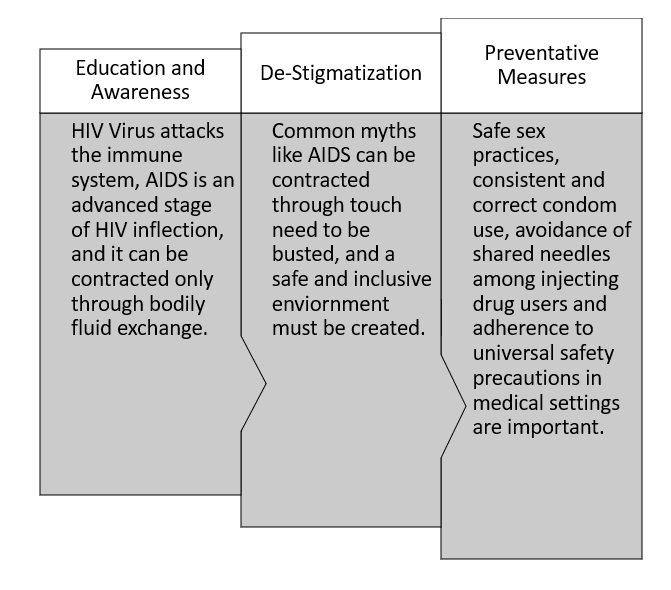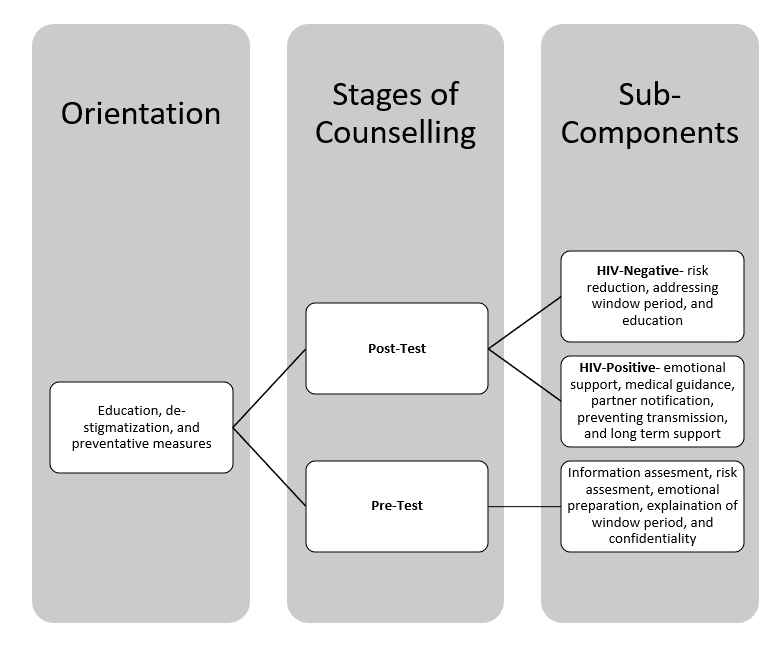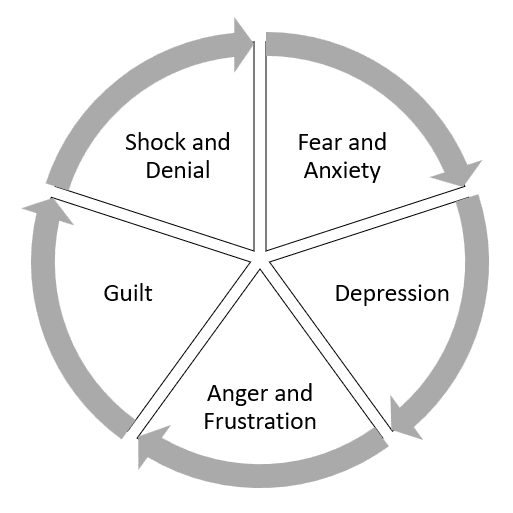Introduction to Counselling for Individuals with HIV/AIDS
Counselling for Individuals with HIV/AIDS is a vital healthcare service designed to support individuals at risk of, or affected by, HIV infection. It is integral to public health efforts, aiming to curb the spread of HIV and provide emotional, psychological, and medical support to those diagnosed with the virus.
The counselling process encompasses three critical phases-
- Orientation,
- Pre-Test Counselling,
- Post-Test Counselling
Together, these phases empower individuals to make informed decisions, reduce risk behaviors, and manage their health effectively.
Read More- Stages of Couselling
Overview of HIV/AIDS
Human Immunodeficiency Virus (HIV) is a virus that attacks the body’s immune system, specifically targeting CD4 cells (T cells), which are crucial for immune defense. If untreated, HIV can lead to Acquired Immunodeficiency Syndrome (AIDS), the most severe phase of HIV infection, where the immune system is severely damaged, making the body vulnerable to opportunistic infections and certain cancers (CDC, 2023).
HIV is primarily transmitted through contact with certain body fluids, such as blood, semen, vaginal fluids, and breast milk. The most common routes of transmission include unprotected sexual intercourse, sharing of contaminated needles, and mother-to-child transmission during childbirth or breastfeeding (WHO, 2023).
The symptoms of HIV vary depending on the stage of infection. The three main stages are-
1. Acute HIV Infection (Early Stage) – 2 to 4 Weeks After Exposure- Some people experience flu-like symptoms, while others may not show any symptoms at all. Common early symptoms include-
- Fever
- Chills
- Sore throat
- Swollen lymph nodes
- Fatigue
- Muscle and joint pain
- Skin rash
- Night sweats
- Mouth ulcers
2. Chronic HIV Infection (Clinical Latency Stage) – Can Last for Several Years- Often asymptomatic (no symptoms). Some may experience mild symptoms, such as persistent swollen lymph nodes HIV is still active but reproduces at very low levels. Without treatment, this stage can progress to AIDS.
3. AIDS (Advanced HIV Stage) – Severe Immune System Damage- At this stage, the immune system is severely weakened, making the body vulnerable to opportunistic infections and certain cancers. Symptoms include-
- Rapid weight loss
- Persistent fever
- Chronic diarrhea
- Profound fatigue
- Sores in the mouth, anus, or genitals
- Pneumonia and other serious infections
- Skin blotches (Kaposi’s sarcoma)
- Neurological issues (memory loss, confusion)
There is no cure for HIV, but antiretroviral therapy (ART) helps control the virus, allowing individuals to live longer and healthier lives while reducing the risk of transmission. Early diagnosis and consistent treatment are key to managing the condition effectively (UNAIDS, 2023).
1. Orientation to HIV/AIDS Counselling
Orientation to HIV/AIDS counselling involves educating individuals about HIV, its transmission, and preventive measures. This stage is foundational, as it establishes a clear understanding of the virus and its implications.
Key Objectives of Orientation
There are four key objectives to orientation, these include-

Counselling for Individuals with HIV/AIDS
1. Educating Individuals about HIV/AIDS-
HIV (Human Immunodeficiency Virus) attacks the immune system, weakening the body’s ability to fight infections. AIDS (Acquired Immunodeficiency Syndrome) is the advanced stage of HIV infection, characterized by severe immune damage.
Modes of transmission include –
- Unprotected Sexual Contact,
- Sharing Of Contaminated Needles,
- Transfusion Of Infected Blood, And
- From Mother To Child During Childbirth Or Breastfeeding.
2. Addressing Misconceptions and Stigma-
Many people hold misconceptions about how HIV spreads, such as through casual contact, sharing utensils, or mosquito bites. Orientation sessions aim to dispel myths and reduce stigma, fostering a supportive environment for those living with HIV.
3. Encouraging Preventive Measures-
Safe sex practices, including consistent and correct condom use, are emphasized. Avoidance of shared needles among injecting drug users and adherence to universal safety precautions in medical settings are discussed.

Steps in Counselling for Individuals with HIV/AIDS
Significance of Orientation
Orientation lays the groundwork for subsequent counselling stages. By providing accurate information and addressing concerns, individuals are better prepared to engage in testing and adopt healthy behaviors.
2. Pre-test Counselling
Pre-test counselling is a crucial step that occurs before an HIV test is conducted. It focuses on preparing the individual emotionally and mentally, ensuring they understand the implications of testing.
Components of Pre-test Counselling
There are 5 components of pre-test counselling, these include-
- Informed Consent- Counsellors explain the purpose, procedure, and potential outcomes of the test. Individuals must voluntarily agree to testing, understanding their rights and options.
- Risk Assessment- Counsellors evaluate the individual’s risk of HIV exposure by discussing factors such as sexual practices, drug use, and medical history. This discussion helps tailor preventive advice and supports the individual in making informed choices.
- Emotional Preparation- The counsellor helps the individual prepare for the possibility of a positive or negative result, addressing fears and anxieties. This step ensures that the individual is emotionally ready to handle the test outcome.
- Explanation of the Window Period- The “window period” refers to the time between HIV infection and the detection of antibodies or antigens in the blood. Counsellors explain that testing too soon after potential exposure may yield false-negative results and recommend retesting if necessary.
- Confidentiality Assurance- Counsellors emphasize that test results will remain confidential and will only be shared with the individual or disclosed with their consent.

HIV Testing Overview
Checklist for Pre-test Counselling
- Explanation of HIV and AIDS
- Modes of transmission and prevention
- Purpose and procedure of HIV testing
- Window period and the need for retesting if applicable
- Medical advantages of knowing one’s HIV status
- Potential emotional and social implications of a positive or negative result
Special Considerations
For individuals at higher risk, such as injecting drug users, men who have sex with men (MSM), and individuals from high-prevalence regions, tailored counselling ensures that their specific concerns and risks are addressed comprehensively.
3. Post-test Counselling
Post-test counselling is conducted after the HIV test results are available. This stage is tailored to the individual’s test outcome, providing appropriate support and guidance.
HIV-Negative Individuals
For those who test negative, post-test counselling focuses on reinforcing preventive behaviors to maintain their HIV-negative status.
- Risk Reduction Strategies- Encouraging safe sex practices, including consistent condom use. Promoting regular testing for individuals with ongoing risk factors.
- Addressing the Window Period- For those who may have been recently exposed, counsellors recommend retesting after the window period.
- Health Education- Counsellors provide information on other sexually transmitted infections (STIs) and their prevention.
HIV-Positive Individuals
For individuals who test positive, post-test counselling is a sensitive and supportive process that addresses emotional, psychological, and medical needs.
- Emotional Support- Counsellors provide a safe space for individuals to process their diagnosis and express their emotions. Assurance of confidentiality helps build trust.
- Medical Guidance- Counsellors explain the availability and benefits of antiretroviral therapy (ART), which can significantly improve health outcomes and reduce transmission risk. They provide referrals to HIV specialists and treatment facilities.
- Partner Notification- Counsellors discuss the importance of informing sexual partners and support the individual in navigating this process.
- Preventing Transmission- Individuals are educated on practices to prevent transmission, such as consistent condom use and avoiding needle sharing.
- Long-term Support- Referrals to support groups, mental health professionals, and social services help individuals cope with the challenges of living with HIV.
Causes of Uncertainty Post-diagnosis
HIV-positive individuals often face uncertainties regarding-
- Disease progression and prognosis
- Social stigma and discrimination
- Disclosing their status to others
- Adherence to treatment and potential side effects
Counsellors address these concerns, helping individuals develop coping strategies and plan for the future.
Psychological and Emotional Aspects
The psychological impact of an HIV diagnosis can be profound. Counsellors play a pivotal role in addressing these challenges.
Psychological Responses to an HIV-positive Result
There can be many different types of responses to HIV-positive result. They can inlude-

Psychological Response to HIV/AIDS Result
- Shock and Denial- Initial disbelief or refusal to accept the diagnosis.
- Fear and Anxiety- Concerns about health, social rejection, and financial implications.
- Depression- Feelings of hopelessness or despair, which may require professional mental health intervention.
- Anger and Frustration- Directed at oneself, others, or the situation.
- Guilt- Particularly common among individuals who perceive their diagnosis as a consequence of past behavior.
Supportive Interventions
Counsellors use empathetic listening, validation, and reassurance to help individuals navigate these emotions. Techniques such as problem-solving and relaxation strategies further support emotional well-being.
Counselling Patients and Partners Together
When both partners are involved in counselling, it helps address shared concerns and facilitates joint decision-making.
- Discussing Sexual Behavior and Lifestyle Adjustments- Partners can openly discuss safer sex practices and address misconceptions about HIV transmission.
- Managing Serodiscordant Relationships- For couples where one partner is HIV-positive and the other is negative, counselling focuses on reducing transmission risks.
- Family Planning- Counsellors provide guidance on reproductive health, including options for having children safely.
- Addressing Psychological Responses- Partners often experience anxiety or distress, which may require individual or joint counselling sessions.
Coping Strategies and Long-term Support
Living with HIV requires ongoing psychological, medical, and social support. Counselling sessions address the following-
Developing Coping Mechanisms
Some ways to develop coping mechanism include-
- Social Support Networks- Encouraging connections with family, friends, and support groups.
- Self-care Practices- Regular health check-ups, balanced nutrition, and exercise.
- Positive Thinking and Resilience- Helping individuals focus on manageable aspects of their lives.
Adherence to Treatment
Patient adherence to ART is critical for its success. Counsellors support adherence by-
- Simplifying medication regimens where possible.
- Addressing side effects and providing strategies to manage them.
- Motivating patients by highlighting the benefits of consistent treatment.
Conclusion
Counselling for HIV/AIDS is a multifaceted process that addresses the medical, emotional, and social aspects of the disease. Through orientation, pre-test, and post-test counselling, individuals gain the knowledge and support needed to make informed decisions, reduce risk behaviors, and manage their health effectively.
The role of counsellors extends beyond the clinical setting, fostering resilience and empowering individuals to lead fulfilling lives despite the challenges posed by HIV.
References
Gyankosh. Unit-4- Counselling for HIV/AIDS Retrived from https://egyankosh.ac.in/bitstream/123456789/23957/1/Unit-4.pdf
Johanson, P. (2007). HIV and AIDS, The Rosen Publishing Group.
Libman, H. & Makadon, H.J. (2007). HIV, 3rd edition, American College of Physicians, ACP Press.
Sadock, B.J. & Kaplan, H. I. & Sadock, V. A. (2007). Synopsis of Psychiatry: Behavioural Sciences/Clinical Psychiatry, 10th edition, Lippincott Williams & Wilkins.
Volberding, P. (2008). Global HIV/AIDS Medicine, Elsevier Health Sciences.
Subscribe to Careershodh
Get the latest updates and insights.
Join 18,526 other subscribers!
Niwlikar, B. A. (2025, January 10). Counselling for Individuals with HIV/AIDS and 3 Critical Stages. Careershodh. https://www.careershodh.com/counselling-for-individuals-with-hiv-aids/
